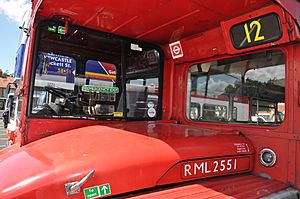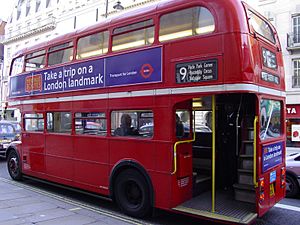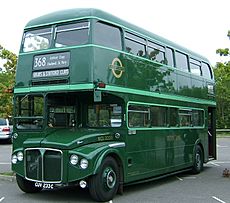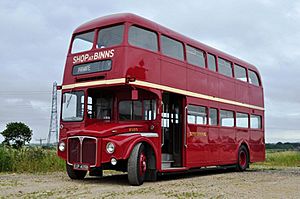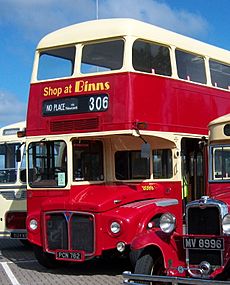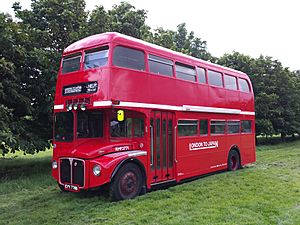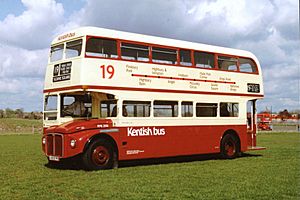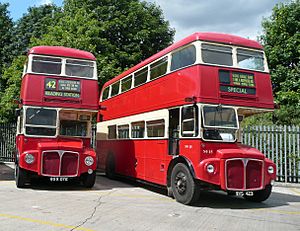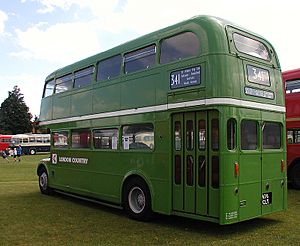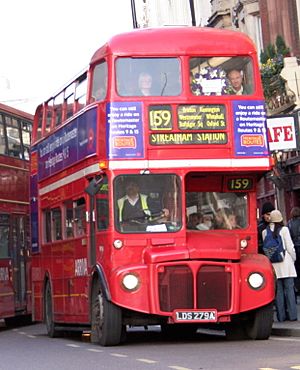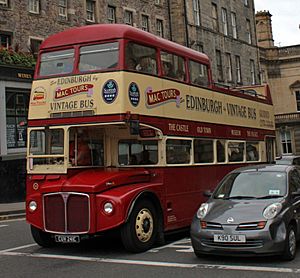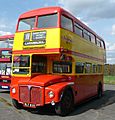AEC Routemaster facts for kids
Quick facts for kids AEC Routemaster |
|
|---|---|
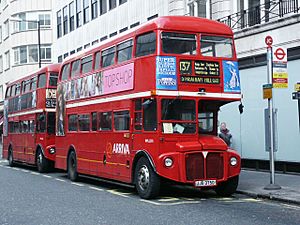
Arriva London Routemasters at Oxford Circus in March 2004
|
|

RM1414 lower deck in October 2006
|
|
| Overview | |
| Manufacturer | Associated Equipment Company |
| Production | 1954–1968 |
| Body and chassis | |
| Layout | Front-engine, rear-wheel-drive |
| Doors | 0 passenger doors, 1 permanently-open entrance at the back and 1 driver's door |
| Floor type | Step-entrance |
| Chassis | Integral, with front and rear subframes |
| Powertrain | |
| Engine | AEC AV590 9.6 L or AEC AV690 11.3 L or Leyland O.600 9.8 L 6-cylinder diesel Retrofits: Cummins ISCe/Cummins ISBe DAF Iveco Scania |
| Capacity | 57–72 seated |
| Power output | 115 hp (86 kW) (AEC AV590) |
| Transmission | AEC 4-speed automatic/semi-automatic |
| Dimensions | |
| Length | 27 ft 6 in (8.38 m) 30 ft 0 in (9.14 m) |
| Width | 8 ft (2.44 m) |
| Height | 14 ft 4+1⁄2 in (4.38 m) |
| Weight | 7.35 long tons (7.47 t; 8.23 short tons) |
| Chronology | |
| Predecessor | AEC Regent III RT |
| Successor | New Routemaster (spiritual) |
The AEC Routemaster is a front-engined double-decker bus that was designed by London Transport and built by the Associated Equipment Company (AEC) and Park Royal Vehicles. The first prototype was completed in September 1954 and the last one was delivered in 1968. The layout of the vehicle was conventional for the time, with a half-cab, front-mounted engine and open rear platform, although the coach version was fitted with rear platform doors. Forward entrance vehicles with platform doors were also produced as was a unique front-entrance prototype with the engine mounted transversely at the rear.
The first Routemasters entered service with London Transport in February 1956 and the last were withdrawn from regular service in December 2005, although two heritage routes were subsequently operated by Routemasters in central London, the last finally being cancelled in April 2021 . The first London bus route to be operated by the Routemaster was route 2, on 8 February 1956, with RM1. The same bus, with a revised front end, appeared at the Lord Mayor's Show in November 1956.
Most Routemasters were built for London Transport, although small numbers were built for British European Airways and the Northern General Transport Company. A total of 2,876 Routemasters were built, of which 1,280 are still in existence.
A pioneering design, the Routemaster outlasted several of its replacement types in London, survived the privatisation of the former London Transport bus operators and was used by other operators around the UK. In modern UK public transport bus operation, the old-fashioned features of the standard Routemaster were both praised and criticised. The open platform, while exposed to the elements, allowed boarding and alighting in places other than official stops; and the presence of a conductor allowed minimal boarding time and optimal security, but with greater labour costs.
In 2006, the Routemaster was voted one of Britain's top 10 design icons which included Concorde, Mini, Supermarine Spitfire, London tube map, World Wide Web and the K2 telephone box. In the late 2000s, work began on a New Routemaster bus inspired by the Routemaster's traditional design. It entered service in February 2012.
Contents
Design
The Routemaster was developed between 1947 and 1956 by a team directed by AAM Durrant and Colin Curtis, with vehicle styling by Douglas Scott. The design brief was to produce a vehicle that was lighter (hence more fuel-efficient), easier to operate and that could be maintained by the existing maintenance practices at the recently opened Aldenham Works, but with easier and lower-cost servicing procedures. The resulting vehicle seated 64 passengers, despite being three-quarters long ton (0.84 short tons; 0.76 t) lighter than buses in the RT family, which seated 56.
The first task on delivery to service was to replace London's trolleybuses, which had themselves replaced trams, and to begin to replace the older types of diesel bus. The Routemaster was designed by London Transport and constructed at Park Royal Vehicles, with the running units provided by its sister company AEC. Both companies were owned by Associated Commercial Vehicles, which was taken over by Leyland Motors in 1962.
It was an innovative design and used lightweight aluminium along with techniques developed in aircraft production during World War II. As well as a novel, weight-saving integral design, it also introduced for the first time on a bus independent front suspension, power steering, a fully automatic gearbox and power-hydraulic braking. This surprised some early drivers, who found the chassis unexpectedly light and nimble compared with older designs, especially as depicted on film on tests at the Chiswick Works skid pan. Footage of RM200 undergoing the skid test at Chiswick was included in the 1971 film On the Buses.
The Routemaster was a departure from the traditional chassis/body construction method. It was one of the first "integral" buses, with a combination of an "A" steel sub-frame (including engine, steering and front suspension) and a rear "B" steel sub-frame (carrying rear axle and suspension), connected by an aluminium body. The gearbox was mounted on the underside of the body structure with shafts to the engine and back axle. Later pre-war London trolleybuses, however, had previously adopted chassisless construction. /
Prototypes
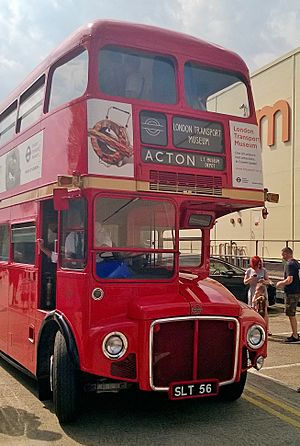
London Transport placed four prototype Routemasters in service between 1956 and 1958. The first two were built at the London Transport works at Chiswick, the third by Weymann at Addlestone and the fourth, an experimental Green Line coach, at Eastern Coach Works at Lowestoft. The third and fourth had Leyland engines and mechanical units. The Routemaster was first exhibited at the Earl's Court Commercial Motor Show in 1954.
In 1961, 24 longer RMLs (30 ft [9.14 m] compared with the standard 27 ft 6 in [8.38 m]) were built as a test, going into production from 1965. In 1962, the front entrance RMF concept was tried, with RMF1254 based on the trial RMLs. This was exhibited and toured, leading to the production of a small number of RMF and RMA buses.
In 1964, just before commencement of mainstream production of the RML, the final front-engined Routemasters, AEC started work on a front-entrance, rear-engined prototype, FRM1. Completed in 1966, it saw regular London service, then on London Coaches tour operations, before being withdrawn in 1983. It was nicknamed the Fruitmaster.
Production
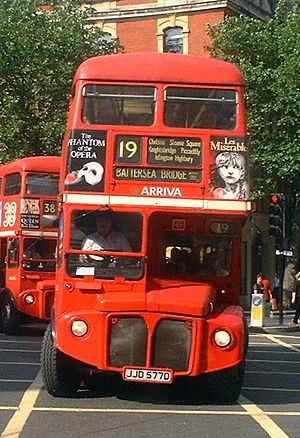
Production of mechanical components was undertaken chiefly at AEC's Southall site (though a significant number had Leyland engines) with body construction and final assembly at Park Royal Vehicles.
Although regulations already permitted 2-axle double deck buses up to 30 feet (9.14 metres) in length by the time the Routemaster went into full production, the majority of production examples were 27 feet 6 inches (8.38 metres) long, the introduction of 29 feet 11 inches (9.12 metres) "long" types being delayed by union resistance to the extra work for conductors.
| Class | Type | Length | Number | Notes |
|---|---|---|---|---|
| RM | standard bus | 27.5 feet (8.38 m) | 2,123 | |
| RML | long bus | 29.91 feet (9.12 m) | 524 | |
| RMC | coach | 27.5 feet (8.38 m) | 69 | |
| RCL | long coach | 29.91 feet (9.12 m) | 43 | |
| RMF | front-entrance bus | 29.91 feet (9.12 m) | 51 | all except one for Northern General Transport Company |
| RMA | front-entrance bus | 27.5 feet (8.38 m) | 65 | for British European Airways |
| FRM | front-entrance bus | 31.3 feet (9.54 m) | 1 | rear engined |
RM & RML class
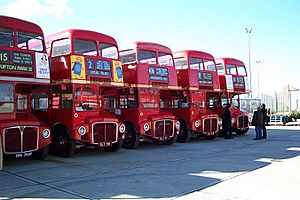
London Transport took delivery of 2,123 RMs and 524 RMLs. The RML was a standard RM with a distinctive and seemingly out of place half-window section added in the middle giving eight extra seats. This was not a dramatic change, as it took advantage of the modular design approach of the Routemaster that would be copied by other manufacturers. The RML code was originally used to identify the "Routemaster Leyland", with what became the RML originally designated the ER (Extended Routemaster). The RM and RML had an area beneath the rear staircase where, when not collecting fares, the conductor could stand without obstructing boarding/alighting passengers. Seating was provided for 64 passengers on RMs (72 on RMLs).
RMC & RCL class
The RMC was a coach version for Green Line routes. RMCs had modified suspension and interiors to allow a longer range and more comfortable running, an electrically operated door instead of an open platform, and a semi-automatic gearbox with higher gear ratios. The RCL was a long version of the RMC with a larger engine and similar coach-style features. Seating was provided for 57 on RMCs and 65 on RCLs.
RMF & RMA class
The RMF and RMA class were production versions of the front entrance Routemaster, primarily for non-London and airline use. Like the RMC/RCL they had an electrically operated door, but at the front of the bus, along with the staircase. After being exhibited and demonstrated to other operators, the RMF attracted little interest, apart from an order from Northern General Transport Company (RMF) and, in a short version, from British European Airways (RMA).
Northern General
The British Electric Traction subsidiary Northern General Transport Company introduced the RMF in 1964/65, with an initial batch of 18, followed by another 32 and later joined by the prototype RMF1254. This order created considerable interest and raised eyebrows within the bus industry, as Northern had been one of the biggest investors in the new rear-engined Leyland Atlanteans.
However, Northern shared many routes with the United Automobile Services, which operated the Bristol Lodekka, and the Atlantean did not match their performance and passenger satisfaction, so Northern brought in the RMFs as a better match. They were fitted with Leyland engines and a higher-ratio rear axle for operation on longer trunk routes. Other notable differences were a standard, single-panel front destination blind, sliding windows and a one-piece driver's windscreen.
They operated in various Northern red and cream liveries receiving the poppy red corporate livery and NBC Northern fleetnames in the National Bus Company era. The RMF fleet wore the long-standing adverts characteristic of buses in the north-east of England, "Shop at Binns". Northern Routemasters were well liked by their crews: the high axle ratio meant a good turn of speed on long-distance routes such as Newcastle to Darlington, and power steering was well appreciated on busy urban services in Gateshead and Sunderland. Their service in the north also produced the odd sight of a Routemaster with a rollsign "X1 Scandinavia", connecting with the DFDS ferry from North Shields to Scandinavia.
However, throughout the 1970s it became increasingly uneconomic to have conductors on inter-urban services. Despite driver and customer satisfaction, Northern had little option but to replace them. Northern placed a large order for Bristol VRs with Eastern Coach Works and Willowbrook bodywork in 1977 to replace them. Withdrawals began in May 1977 with the last withdrawn in October 1980. Most were scrapped although 14 were sold to London Transport. Only one entered service, as an open-top with London Coaches.
British European Airways
British European Airways purchased 65 RMAs built to the shorter length (with trailers) in 1966/67 for use on its airport bus service between the West London Air Terminal and Heathrow Airport. They were geared for 70 mph running on the M4 Motorway. Withdrawals started in January 1975 with British Airways discontinuing the service in March 1979. All 65 RMAs were eventually sold to London Transport.
Safety
The open platform is potentially dangerous, as passengers can board, alight, and stand on the platform at any time, even with the bus travelling at speed. The presence of a conductor to regulate access to the platform helps, but the conductor also has to collect fares throughout the bus, and even if on the platform cannot prevent all incidents. Former London mayor Ken Livingstone said in 2013 that the Routemasters were too dangerous, with around twelve people per year losing their lives after falling from them during his mayoralty.
Colour schemes
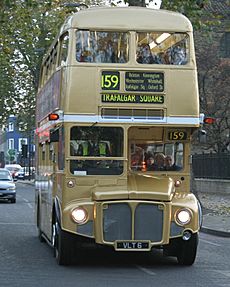
With the Routemaster's longevity, examples were painted to celebrate both the Queen's Silver and Golden Jubilees. In 1977, 25 Routemasters were painted silver and temporarily renumbered SRM1 to SRM25 to celebrate the Silver Jubilee and, in 2002, 50 buses were painted gold including three RMs and 12 RMLs.
During privatisation in London from 1986, several private operators won contracts to operate services, including Routemaster-operated routes. Before an 80% red rule for liveries was introduced in 1997 by London Transport, the contract tendering authority, some of these new entrants ran Routemasters in non-red liveries, most notably Kentish Bus on route 19 and Borehamwood Travel Services on route 13.
The Routemaster appealed to the many new operators outside London that appeared post-1986 in the UK following bus deregulation. Several traditional operators purchased second-hand Routemasters as a cheap way of expanding their fleets in response to competition from new operators after deregulation, and new operators also chose it as a distinctive-looking bus. Painted in a variety of colours, they were used in regular service in Bedford, Blackpool, Burnley, Carlisle, Corby, Doncaster, Dundee, Glasgow, Hull, Manchester, Perth, Rotherham. Scarborough, Southampton and Southend-on-Sea.
One of the earliest examples, if not the earliest, of deregulated use of Routemasters was early in the history of the Stagecoach Group, by 2014 one of the largest operators in the UK. Stagecoach used vintage Routemasters in its new corporate livery of all-over white with red, orange and blue stripes, to start one of its first operations, Magic Bus, in Glasgow in the late 1980s.
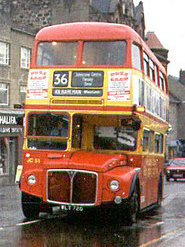
In the mid 1980s Clydeside Scottish purchased 114 Routemasters for use in Glasgow, with many repainted at Aldenham Works. Most were withdrawn in 1990.
Towards the end of this period, in July 1994 in Reading, new operator Reading Mainline built up a 45-strong Routemaster fleet to compete with the established operator, Reading Buses, in the process becoming the largest operator of Routemasters outside London. They used conductors to compete on speed in the town centre and, in the outskirts, took advantage of the rear platform to operate hail and ride sections of route. In 1998 Reading Mainline was sold to Reading Buses; some Routemasters continued in use until July 2000.
With the costs of running elderly two-crew buses, and with a general reduction in the number of operators, buses, and services in the years following deregulation as competitors merged or closed, use of Routemasters outside London declined through the 1990s. Many of these buses found their way back to London to assist with the refurbishment programme, as spares donors or to increase fleet size.
Withdrawal from mainstream London service saw another resurgence in the use of Routemasters outside London, but on a smaller scale than immediately after deregulation. After 2000 Routemasters were mostly used on small novelty or seasonal routes.
Green livery
The first green Routemasters, apart from prototype CRL4, now RMC4, were 69 RMCs (Routemaster Coach) for Green Line work. These were the same length as the RMs but had luxury seating, luggage racks, strip lights and platform doors. The later 43 RCLs (Routemaster Coach Lengthened) were the same length as the RMLs but again with coach seating and platform doors.
One hundred green Routemasters, based on the RMLs, were delivered in 1965/66 for Country area bus work. Three of these were transferred to the Central (Red) fleet in 1969 in exchange for three XA Leyland Atlanteans.
On 1 January 1970 these green Routemasters were transferred to the newly formed London Country Bus Services, a National Bus Company subsidiary formed to take over London Transport's Country Area. London Country announced that it intended to convert all its services to one-man operation, which it achieved by 1981, making all the Routemasters redundant. Many were sold back to London Transport, the RMCs becoming trainers along with most of the RCLs.
Most of the ex-Country RMLs that were sold back to LT in the late 1970s lasted longer as red buses than they did in green! (Most did 14 years as green buses but over 20 as red buses.) Some RCLs had the platform doors removed and entered service as red buses. RMC4 (ex CRL4) was kept by London Country but was later sold when the NBC was sold off.
Rise and decline
Peak use by London Transport
The peak era of the Routemaster was in its first 25 years of operation, until September 1982, when the type started to be withdrawn and transferred to training fleets, due to service reductions.
The RM class entered service from 1959 to replace trolleybuses, which finished in May 1962. Subsequent Routemasters, the last 500 of which were RMLs, began replacing the previous generation of buses, the AEC Regent RT and Leyland Titan RTL and RTW. RMLs also displaced RMs on central routes to cope with higher loadings. The last Routemaster entered service in March 1968.
The original concept included the routine overhaul and refurbishment of the fleet at LT's Aldenham Works, usually every five years. The buses were completely stripped down and rebuilt, and left the works almost as new. As the number of Routemasters declined, financial cutbacks and newer buses not suited to this practice were introduced, the overhaul routine was abandoned and Aldenham Works closed in November 1986. The thoroughness of the Aldenham system was the primary reason why the Routemaster and its predecessors lasted so long in London service.
Decline in London
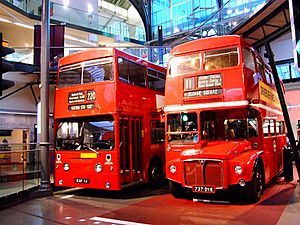
Many routes were converted to driver-only operation ("DOO" or "OMO") in the 1970s, to reduce operating costs and in response to staff shortages. There was also for a time a parts shortage for Routemasters, aggravated by the closure of AEC. With the introduction of single-deck Red Arrow services and successful conversion to modern, rear-engined OMO buses around the country, London Transport considered replacing Routemasters with modern buses.
The operation of the Routemaster gradually contracted to central areas only, with RMLs replacing RMs, where it was felt that the Routemaster still provided an efficient means of transporting large enough numbers of people to justify the economics of two-crew operation. The rapid acceleration and rugged construction of the Routemaster proved to be more suited to urban conditions than some more modern designs.
The fleet remained largely intact for around 15 years after production ended in 1968, with withdrawals mainly due to fires. Following the defeat of the Greater London Council in the House of Lords over its subsidised fare scheme, major service reductions followed in September 1982. Consequently, the first withdrawals commenced, with many of these early disposals being for scrap. The continued practice of route conversion to one-person operation resulted in a steady trickle of withdrawals. This practice had largely halted by 1988, with comparatively few withdrawn up to 1992.
In 1986 some of the Routemasters purchased from British European Airways, London Country and Northern General, which had doors rather than an open platform, were overhauled at Aldenham Works and put in service on London Transport's revived sightseeing operation The Original London Sightseeing Tour, alongside RCLs (some converted to open top buses), RMFs and RMAs.
Privatisation of London Buses
In April 1989, in preparation for the privatisation of London bus services, London Buses was divided into 11 arm's-length business units based on different garages. Eight units inherited Routemasters: CentreWest, East London, Leaside, London Central, London General, London Northern, London United and South London. During this time, following the failure and premature withdrawal of heralded replacement vehicle classes such as the Daimler Fleetlines, the Routemasters that had not yet been disposed of saw their lives extended for use until privatisation. Where new route tenders called for Routemaster operation, these were leased from London Buses.
Between September and November 1994, all of the business units were sold. In the new London route tendering process, all but one of the Routemaster-operated routes (139) retained their now privately owned Routemasters for the five-year contract period and further refurbishments resulted.
Life extensions
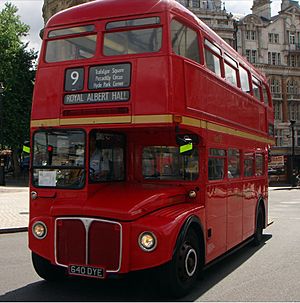
Following the ending of production at AEC Southall, and the later closure of the Aldenham Works, new options for extending the life of the Routemaster became necessary if they were to continue to run. This made sense as, even by 1987, when some buses looked decidedly worn out, inspections by London Buses revealed the basic structure of the buses was still sound, requiring only replacement of engines and interior/exterior renewal.
From 1992 to 1994, all but two of the RMLs were refurbished for ten years' further service. This work, which included updating the interior to modern tastes and substituting Cummins or Iveco engines, was carried out by Mainline, TB Precision, Nottingham Truck & Bus and by one of the new London Buses business units, Leaside Buses. One hundred RMs were also re-engined. Post-privatisation, in 1996, London Central's RMs on route 36, Stagecoach London's RMLs for routes 8 and 15, and Arriva London's RMs for route 159 received new Scania engines and a number of subtle reworks including hopper style windows.
In 2001/02, under new Mayor of London Ken Livingstone, Transport for London purchased 50 RMs from a variety of sources, including Reading Mainline and two from Italy. Of these, 43 were refurbished by Marshall Bus between May 2001 and August 2002, receiving Cummins engines coupled to an Allison automatic gearbox. They also received a full body overhaul including new hopper windows. The first 22 were leased to London Sovereign for use on route 13 with ten going to Arriva London for use on route 38 and others to First London, London Central and London United. After Marshall Bus went into administration, Arriva London completed a further six, albeit without the heavy body overhauls and retaining the quarter-drop windows.
Withdrawal from London
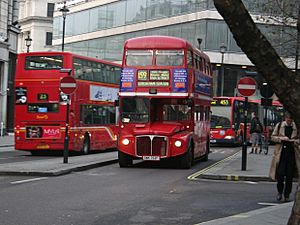
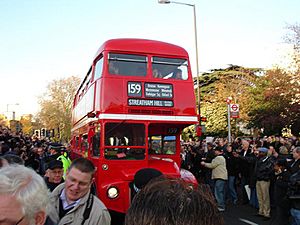
At the beginning of the 2000s, there was debate concerning the issue of whether to replace or retain the Routemaster in London service. Supporters cited its continued mechanical fitness, speed of boarding and tourist potential, while opponents pointed to the economics of running increasingly elderly buses when newer, larger and more modern designs were now on the market following a resurgence in the bus manufacturing industry after recession in the 1990s.
Opponents also pointed specifically to the lack of accessibility of the Routemaster in light of impending relevant legislation, which meant all new buses now entering service in London would be required to have a low-floor design. The emergence of off-bus ticketing technology also reduced the argument for better dwell times, whereby the Oyster card and off-bus ticket machines would reduce the time it took passengers to board the bus.
With Transport for London purchasing fifty Routemasters and having them thoroughly rebuilt in 2001/02, it appeared that the Routemasters would be around for some time to come. In February 2003, route 10 was split, with the Kings Cross to Hammersmith section converted to driver-only operation and the Archway to Marble Arch section remaining Routemaster-operated as route 390. In the same month route 36 was curtailed between Lewisham and New Cross and duplicated by route 436 between New Cross and Paddington, operated by Mercedes-Benz Citaro articulated buses.
In March 2003, Transport for London managing director Peter Hendy advised that accessibility was a higher priority than retaining conductors, and in August 2003, as the existing contracts became due for renewal, the remaining Routemaster services were replaced, either by low-floor double-decker buses or articulated buses. Government legislation required full accessibility on 22 October 2014 under the Disability Discrimination Act; however, Transport for London was aiming to be compliant far earlier. As a consequence, the last Routemasters were withdrawn from general service on 9 December 2005, although two heritage routes - 9 and 15 - were introduced. This was reduced to one on 25 July 2014.
Withdrawals began on the dates below as the five-year contracts expired.
| Route | Ceased | Operator | Replaced by |
|---|---|---|---|
| 15 | 29 August 2003 | East London | double-deckers |
| 11 | 31 October 2003 | London General | double-deckers |
| 23 | 14 November 2003 | First London | double-deckers |
| 94 | 23 January 2004 | Transdev London United | double-deckers |
| 6 | 26 March 2004 | Metroline | double-deckers |
| 98 | 26 March 2004 | Metroline | double-deckers |
| 8 | 4 June 2004 | East London | double-deckers |
| 7 | 2 July 2004 | First London | double-deckers |
| 137 | 9 July 2004 | Arriva London | double-deckers |
| 9 | 3 September 2004 | Transdev London United | double-deckers |
| 73 | 3 September 2004 | Arriva London | articulated buses |
| 390 | 3 September 2004 | Metroline | double-deckers |
| 12 | 5 November 2004 | London Central | articulated buses |
| 36 | 28 January 2005 | London Central | double-deckers |
| 19 | 1 April 2005 | Arriva London | double-deckers |
| 14 | 22 July 2005 | London General | double-deckers |
| 22 | 22 July 2005 | London General | double-deckers |
| 13 | 21 October 2005 | Transdev London Sovereign | double-deckers |
| 38 | 28 October 2005 | Arriva London | articulated buses |
| 159 | 9 December 2005 | Arriva London | double-deckers |
On 9 December 2005, the last Routemasters ran on route 159. On 8 December 2005, 24 special buses, including preserved RMs and RMLs and their predecessors from the AEC Regent III RT bus family made guest appearances on route 159.
On the last day, on police advice, instead of doing a normal shift, with crews working until around 23:00, the last Routemaster services ran in the middle of the day. RM2217 operated the final departure from Marble Arch at 12:08. Heavily delayed, it took 10 minutes to turn the final corner into Brixton garage arriving at 14:06.
Around the time of the last runs to the garage, crowds blocked the four-lane road, bringing all traffic to a standstill.
After 2005
London heritage routes
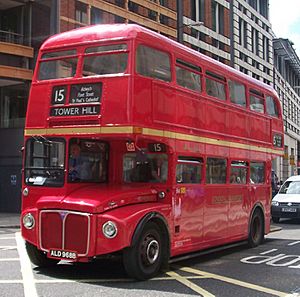
In November 2005 heritage routes 9 and 15 were introduced, operating daily until 18:30, duplicating short sections of two regular London bus routes. Heritage Routes 9 and 15 were withdrawn on 25 July 2014 and 29 September 2019.
The two operators, First London and Stagecoach London, each operated ten buses selected from the batch overhauled by Marshall Bus in 2001/02.
During the operation of Heritage Route 15, Stagecoach East London refurbished their Routemasters with some of the modern features added during the Marshall refurbishments replaced by replicas of the original equipment. This is being done by Hants & Dorset Trim, and involves a full overhaul and repaint inside and out, the return of gold lettering, black registration plates and fitting of modern LED indicators on the front and LED indicators and lights on the rear. These have been made to appear similar to the round lights that were originally fitted. The refurbishment also sees the removal of the yellow hand rails, and the return of steel with white coating rails, also a nod to the original design. The first refurbished vehicle was delivered back to Stagecoach East London in January 2016.
As of 2021 the Heritage Routes with Routemaster are cancelled.
Tour and charter use
Aside from the London heritage route, the last major operation of Routemasters was in Edinburgh, where Lothian Buses' tour operation, Mac Tours used open-top Routemasters on regular tours. The last were withdrawn in October 2016.
The Afternoon Tea Bus Tour operates as a tourist service in London. Many Routemasters remain in service as charter buses, both with the companies that operated them in London and with niche charter operators.
Routemasters have also been exported, with some seeing further service in Australia, Canada (Victoria, British Columbia, Niagara Falls, Ontario and Toronto), China, Colombia, Croatia, the Falkland Islands, Malaysia, New Zealand, Sri Lanka and the United States. A number of Stagecoach Routemasters have been exported to Montreal in Canada, where Stagecoach provides a tourist service around the city.
Ensign
Bus dealer Ensignbus handled disposals of the Routemasters, as it had long done for other London buses. In December 2004, Ensignbus held a raffle for 32 Routemasters, available for £2,000 to those who could prove they had the finances to store and care for them.
50th and 60th anniversary
On 25 July 2004, 98 Routemasters were lined up in Finsbury Park, in celebration of the 50th anniversary of the first appearance of RM1. A repeat event occurred in July 2014 for the 60th anniversary and a record breaking 136 Routemasters attended. Both events were organised by the Routemaster Association.
Notable examples
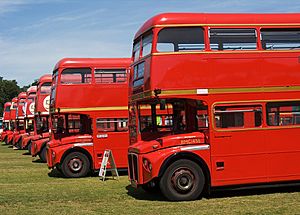

- In February and August 1986 RM1 and RM2 were placed in the custody of the London Transport Museum
- In February 1974 RML3 was sold to Cobham Bus Museum (now the London Bus Museum) (L in this case stood for Leyland). This vehicle has had a replica of its original front fitted.
- Prototype coach RMC4 (originally CRL4) is preserved by Roger Wright of the London Bus Company and is being fitted with a replica of its original front.
- On 28 April 2010, Roger Wright repatriated RM1371 and RM1620, along with seven RTs and two RTLs from Charlottetown, Prince Edward Island, Canada. London Bus Company purchased the fleet from Charlottetown-based Abegweit Tours and Travel Agency Inc., which had operated them since 1965. The buses were driven to Halifax, Nova Scotia for shipment to the UK. Some are destined for tourist operation in London while the remainder will be preserved in museums.
- The first production Routemaster, RM8, is preserved by the RM8 Club. It was displayed at the 1958 Commercial Vehicle Show as the new bus for London. It was employed at Chiswick Works as an experimental vehicle upon which many Routemaster modifications were tested. The bus finally entered public service at Sidcup garage in March 1976, being the last Routemaster to enter service and the last open-platform bus to be introduced into service in the UK. It served LT at Sidcup garage until the garage went "one-person" in 1985. It was then preserved by the RM8 Group, which subsequently became the RM8 Club. In July 2008, the bus was restored to its 1958 Commercial Vehicle Show appearance, complete with replica posters and blinds.
- The 1,000th Routemaster, RM1000, was handed over to London Transport with a ceremony at Southall Works on 16 October 1961, and adopted as a showbus by staff at Croydon garage; it passed to the RM1000 Preservation Group for preservation in May 1987.
- The unique rear-engined front entrance Routemaster, FRM1, was transferred to the London Transport Museum for preservation in 1983.
- RM1737 was the show bus of Ash Grove bus garage in the early 1980s. It passed into TfL ownership and is displayed at the London Transport Museum.
- RM737 was the show bus at Harrow Weald garage and, despite being in daily service on route 140, was regularly seen at preservation rallies. Purchased by the show bus team when route 140 was converted, it was the first standard example in preservation. It is now operated for private hires by The Red Bus Ltd. in Edinburgh.
- RM1403 was the first Routemaster to be converted to an open-top. It was converted in 1984 at Aldenham using a special, curved roof design only seen on two Routemasters. RM1403 is the only open-top Leyland Routemaster in the world and is currently owned by A Route 2 Hire. The bus has made several notable public appearances including the transport of the Watford football team and Brawn GP F1 team.
- RM2217, which operated the last regular Routemaster service in London in December 2005, has been retained by Arriva London in its Heritage Fleet, along with RM5 and RM6, and the first production RMC coach RMC1453, among others. The bus also appears as the front cover picture (with the author as the driver) of Ian Nairn's 1966 book Nairn's London.
- RML2537 is preserved in open-top form at Long Beach, California and operated in connection with the Queen Mary, which is permanently berthed there as a floating hotel.
- The last Routemaster built for London, RML2760, is retained by Stagecoach London.
- The first RCL, RCL2218, is preserved at the Nottingham Transport Heritage Centre.
- Several RMAs are operated by Joe Letts and the Big Red Bus Company.
Images for kids
-
A Routemaster in Tampere, Finland
-
Routemaster RM1005 in Pinner in 2012, during a running day
-
Metroline New Routemaster on route 24 in Camden Town in June 2013
-
Routemaster converted into a mobile "chip van". This is operated by The London Bus Fish And Chip Company.
-
Routemaster (painted white and advertising four varieties of Kit Kat chocolate bar) converted into a mobile radio station by Capital London
See also
 In Spanish: Routemaster para niños
In Spanish: Routemaster para niños


